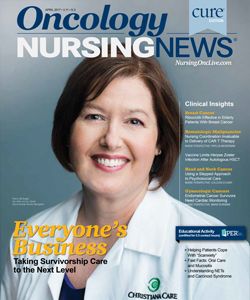After Cancer Treatment, Nurses Help Survivors Find Their Way
OncLive Chairman, Mike Hennessy

OncLive Chairman,
Mike Hennessy
Statistics about the growing number of individuals joining the ranks of "cancer survivor" are truly heartening. Currently, there are more than 15 million US cancer survivors, and that number is expected to grow by at least one-third to 20 million over the next decade.
These are numbers I suspect even the most optimistic cancer research- er and practitioner might not have imagined even only a few years ago. Yet with this good news comes a re- sponsibility for the nation’s health- care providers—and not just those working in oncology. As survivorship nurse navigator Darcy Burbage notes in our cover story this month: “Survi- vorship care is everyone’s business.”
And, indeed, that chord was struck over and over again at the 2017 Can- cer Survivorship Symposium, where hundreds of researchers, healthcare professionals, survivors, and advo- cates convened for this annual conference where oncology and primary care practitioners share the latest research on providing optimal survivor care.
In this issue of Oncology Nursing News®, we highlight just a sampling of those presentations; many more can be found on Nursing.OncLive.com. And Burbage gives readers an up- close look at how survivorship care is delivered at the Helen F. Graham Cancer Center & Research Institute in Delaware, a community cancer cen- ter. It looks different, she notes, than how survivor care is delivered at larg- er academic medical centers, under- scoring a point oncology nurses know well: when it comes to survivorship, there is no one-size-fits-all approach.
Also in this issue, Pamela Gaytan, nurse and neuroendocrine specialist at the Rocky Mountain Cancer Cen- ter in Denver, provides her peers with a primer on treating and supporting patients with neuroendocrine tumors and carcinoid syndrome. Her insights are well-timed, following on the FDA’s recent approval of telotristat ethyl (Xermelo), a new drug for the treatment of carcinoid syndrome—re- lated diarrhea in these patients.
The full implementation of the new USP <800> standards for handling hazardous drugs will happen in July 2018 and oncology nurses and others who work with these agents need to be prepared.
In her column this month, nurse safe handling expert Martha Polovich explains why closed system transfer devices are mandatory under the new standards for the administration of antineoplastic agents and shares guid- ance on their use.
As always, we hope that you find the information in these pages helpful, and thank you for reading.
—Mike Hennessy
Chairman and CEO

Innovative Program Reduces Nurse Turnover and Fosters Development
Published: September 12th 2024 | Updated: September 12th 2024The US Oncology Network (The Network) has developed one of the most comprehensive programs in the nation to support the professional development and retention of new oncology nurses.


